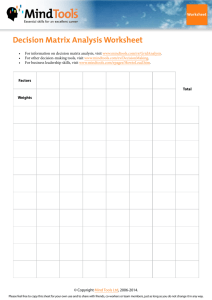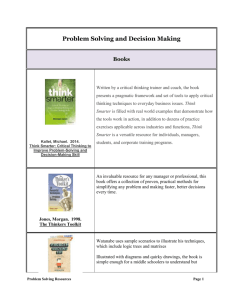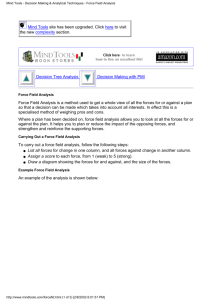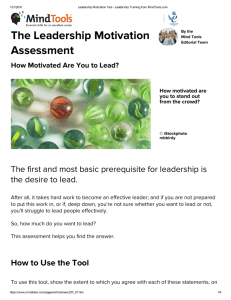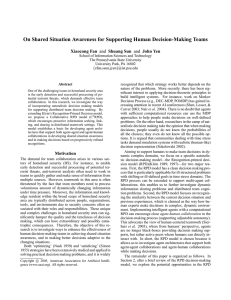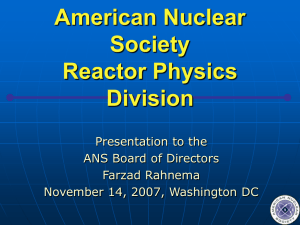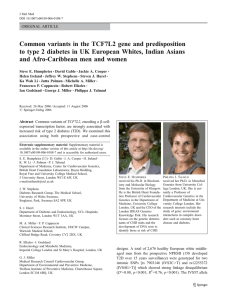The Recognition-Primed Decision (RPD) Process
advertisement
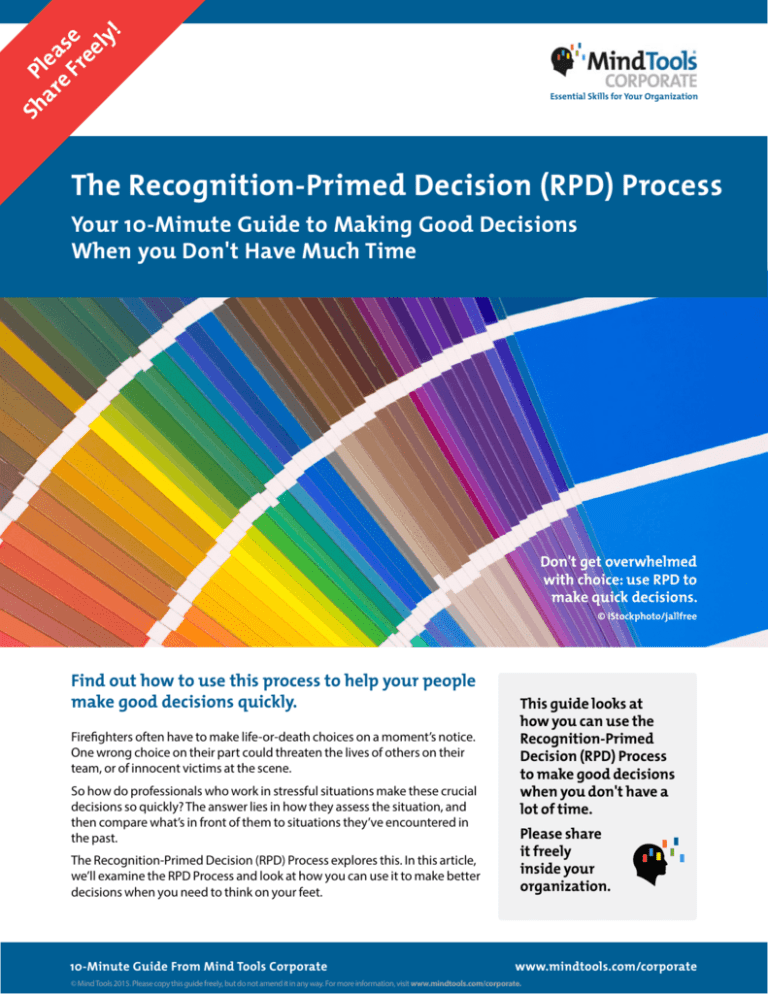
P ar lea e F se re el y! Sh Essential Skills for Your Organization The Recognition-Primed Decision (RPD) Process Your 10-Minute Guide to Making Good Decisions When you Don't Have Much Time Don't get overwhelmed with choice: use RPD to make quick decisions. © iStockphoto/jallfree Find out how to use this process to help your people make good decisions quickly. Firefighters often have to make life-or-death choices on a moment’s notice. One wrong choice on their part could threaten the lives of others on their team, or of innocent victims at the scene. So how do professionals who work in stressful situations make these crucial decisions so quickly? The answer lies in how they assess the situation, and then compare what’s in front of them to situations they’ve encountered in the past. The Recognition-Primed Decision (RPD) Process explores this. In this article, we’ll examine the RPD Process and look at how you can use it to make better decisions when you need to think on your feet. 10-Minute Guide From Mind Tools Corporate This guide looks at how you can use the Recognition-Primed Decision (RPD) Process to make good decisions when you don't have a lot of time. Please share it freely inside your organization. www.mindtools.com/corporate © Mind Tools 2015. Please copy this guide freely, but do not amend it in any way. For more information, visit www.mindtools.com/corporate. Essential Skills for Your Organization About the RPD Process How to Use the Process The RPD Process was created by research psychologists Gary Klein, Roberta Calderwood and Anne Clinton-Cirocco in the late 1980s. Klein then published it in his 1999 book, “Sources of Power: How People Make Decisions.” Klein is best known for pioneering the field of naturalistic decision making – the study of how people make decisions in demanding situations. As we mentioned above, the RPD Process is based on pattern recognition and past experiences. So it’s not a process that you can learn and then apply whenever you need to make a quick decision. Klein, Calderwood and Clinton-Cirocco developed the process after studying professionals who regularly make quick, life-or-death decisions, such as firefighters, emergency medical technicians/paramedics, and nuclear technicians. They found that existing decision-making models didn’t adequately explain how people make good decisions under pressure. The RPD Process highlights the three simple steps that we go through, often subconsciously, when we need to make a quick decision. This is based on “pattern recognition,” and on how we can use our past experiences of similar situations to make decisions. The three steps are: 1. 2. 3. Experiencing the situation. Analyzing the situation. Implementing the decision. Let’s look at each step in greater detail. 1. Experiencing the Situation The first step is simply experiencing the situation we’re in. We listen to what’s going on and look at how events are unfolding. However, you can prepare yourself and your team for making better decision in these situations by working through training scenarios. This helps you to recognize patterns and cues in situations where you need to make a quick decision. Let’s look at a process for doing this effectively: 1. Identify Possible Situations Begin by brainstorming situations and scenarios where you or your team will need to make quick, accurate decisions. Also, think about situations where you’ve made wrong decisions in the past. Generally, these will be situations where you won’t have time to use a step-by-step decision-making process, and where the wrong decision will have serious negative consequences. If you’re unsure of the consequences, analyze situations using tools such as Risk Analysis, Impact Analysis and the Futures Wheel. (You may not want to continue with this process if the consequences of getting decisions wrong are minor.) 2. Create Training Scenarios 2. Analyzing the Situation Next, create training scenarios that simulate the situations you’ve identified. Define the problem you need to solve clearly, and identify positive and negative outcomes. Next, we analyze the situation. We do this by asking questions such as: Then describe the situation in as much detail as you can. This will help you simulate the situation in the next step. 3. Simulate the Situation • • • Is this a situation that we’ve experienced before? Are there familiar patterns that we recognize? Is the situation playing out as we would expect? In this stage, we gather enough information to help us make a decision. This is the most important part of the process. 3. Implementing the Decision The last step is to take action and implement the decision. 10-Minute Guide From Mind Tools Corporate Now, put yourself or your team members in a situation that, as closely as possible, simulates the stress and time pressure of the real situation. (Techniques such as Active Training and Role Playing can be useful here.) Work through each scenario, or variation of it, several times. Think about how you handled the situation, and the consequences of your decision. What would have led to a better outcome? Was it a good or bad outcome? www.mindtools.com/corporate © Mind Tools 2015. Please copy this guide freely, but do not amend it in any way. For more information, visit www.mindtools.com/corporate. Essential Skills for Your Organization What could you have done differently? decision by forming “expectations” – these are educated guesses at how it will play out. If these expectations change as the situation evolves, it can mean that you might have misunderstood the situation. Here, you’ll also find it useful to break situations down so that you can analyze them in more detail. You can do this by: • • Identifying what you can realistically accomplish – What do you need to do first when faced with the situation? What are your priorities? Recognizing signals, cues and patterns – What is happening that will affect your decision? What makes this situation the same or different from other ones? Have you seen this situation or a similar one before? Tip 1: You may also find it useful to “shadow” someone else in the situations you’ve identified. Again, use the questions above to break the situation down so that you can think about how you would have made a decision. Tip 2: When you’re faced with a real situation, Klein says that you can check the accuracy of your possible Key Points The RPD Process was created by Gary Klein, Roberta Calderwood and Anne Clinton-Cirocco, and published in Klein’s 1999 book, “Sources of Power: How People Make Decisions.” The process highlights how we make decisions under pressure, time constraints, and shifting conditions. There are three main steps: 1. 2. 3. Experiencing the situation. Analyzing the situation. Implementing the decision. The process highlights how important pattern recognition and past experience is for making quick decisions. You can prepare yourself for this by working through training scenarios that simulate situations where you’ll need to make fast and accurate decisions. Visit www.mindtools.com/corporate to find out how your organization can access more than 1000 articles on leadership, management, problem solving, and communication. You can also license more than 60 one-hour training courses and hundreds of business podcasts. Used together, these resources help develop and embed skills organization-wide. 10-Minute Guide From Mind Tools Corporate www.mindtools.com/corporate © Mind Tools 2015. Please copy this guide freely, but do not amend it in any way. For more information, visit www.mindtools.com/corporate.
